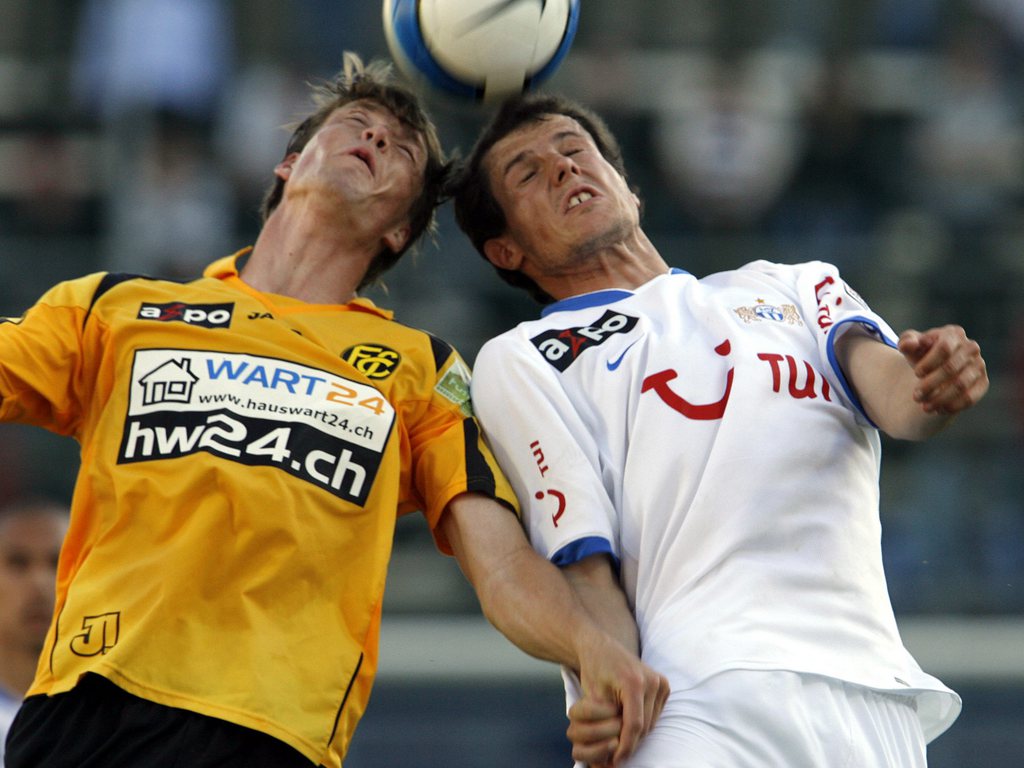Concussion: FIFA and Swiss leagues put their heads together

Following a series of shocking head injuries during the recent football World Cup in Brazil, FIFA, the sport’s world governing body, denies accusations that it doesn’t take players’ health seriously. It has recently launched a pioneering study in the Swiss league.
Christoph Kramer, Javier Mascherano and Pablo Zabaleta all played on despite picking up head injuries that left them dazed and confused. But it was the reaction to the concussion to Álvaro Pereira that generated the most media criticismExternal link.
Pereira described it like the “lights going out” when an opponent’s knee hit his headExternal link. After arguing with the team physician, he was allowed to finish the game. This incident immediately sparked FIFPro, the players’ union, to call for new protective measuresExternal link.
Regarding Kramer’s injuryExternal link, FIFPro spokesman Raymond Beaard told swissinfo.ch that the organisation’s chief medical officer was “shocked to say the least” when he saw on the replay how Kramer had gone down, saying it was “quite clear” that he could not continue.
“What we’re critical of is that we have the impression that no real action was taken at that moment to protect the health of the player,” Beaard said.
“In the old days people would cheer on a player with a head wound who ran back onto the pitch wearing a bandage. But the game has changed so dramatically in the past 20-30 years – it has become much faster and more physical, so the impact of a collision is far, far greater than it was before. That said, scientific knowledge has also increased. We know much more about the consequences of head injuries and concussions and about the risks.”
‘Inappropriate’ criticism
However, Zurich-based FIFA dismisses claims it is trivialising players’ health.
“It’s very difficult to make a medical diagnosis from TV images and it could be misleading,” Jiri Dvorak, FIFA’s chief medical officer and senior consultant at Zurich’s Schulthess Clinic, told swissinfo.ch.
“Take the example of Christoph Kramer. When the incident happened, of course the audience saw it on the television, but the referee and doctors couldn’t see it when they ran to the player, who assured them he was all right,” he said.
“The German team doctors are very experienced and Kramer didn’t report any symptoms or signs, so he was allowed to play on. Then over the next ten minutes he realised that symptoms were occurring – it’s not unusual that there is a delay – and he himself called the doctors for attention.”
So the criticism is unfair? “FIFA has a track record of 20 years of doing studies to see what can be done to make the game healthier and promote it as a health-enhancing leisure activity. So I would not use the word unfair – I would say inappropriate.”
Dvorak also stressed that FIFA takes head injuries “extremely seriously”, pointing to extensive studies between 2001-2005 which analysed head-to-head, head-to-ball and elbow-to-head collisions.
In 2006, these studies prompted the introduction of a new rule stating that any player deemed to have deliberately elbowed an opponent in the head must be sent off, a rule which FIFA says has since halved the number of serious footballing head injuries.
Swiss study
Indeed, football involves the use of one’s head more often than the sport’s name would suggest: according to FIFA, 13% of all injuries sustained at World Cups involve the head and neck, with roughly one in seven of those injuries resulting in concussion.
A 2012 documentary, Head Games: The Global Concussion Crisis, examined the effects of repeated concussions, particularly in sport. It focused on American football and ice hockey, but also covered football, boxing, lacrosse and professional wrestling:
As well as prevention, determining the most appropriate treatment for footballers after head injuries is also crucial. With this in mind, researchers from University Hospital Zurich’s Department of Neurology and Zurich’s Schulthess Clinic have launched a collaborative project with FIFA.
The Swiss Concussion Project involves all players in Switzerland’s top male league and top female league for the 2014/15 season. Each league has ten teams, with around 520 players being assessed in total.
“They will get a baseline examination of their neurological system – including balance, coordination, eye movements and neuropsychological performance,” project leader Nina Feddermann-Demont from University Hospital Zurich’s Department of Neurology told swissinfo.ch.
“In the event of a head injury, we will do follow-up testing. Differences between baseline and post-injury results are key to determining how fast players can return to training and match play. The availability of baseline data is crucial in determining the impact of a head injury because most neurological functions – such as reaction times, speed and balance – differ from player to player,” she said.
“We have a 24/7 hotline for the team physicians. For us it is essential to work closely with them, because they are the ones on the sidelines and they know the players. Usually they give us a call or send us an email when a head injury has occurred and then we offer a follow-up test, which includes the repetition of the baseline test within 72 hours.”
Football injuries
Protection against head injuries in soccer is complicated by the fact that heading is an established part of the game, and any attempt to protect against head injuries must allow the game to be played without modification. Several head guards have been developed to reduce the risk of head injuries in soccer. One independent research study found that none of the products on the market provided substantial benefits against minor impacts, such as heading with a soccer ball.
A McGill University study found that more than 60% of college-level soccer players reported symptoms of concussion during a single season. Although the percentage at other levels of play may be different, these data indicate that head injuries in soccer are more frequent than most presume.
According to Consumer Product Safety Commission statistics, 40% of soccer concussions are attributed to head to player contact; 10.3% are head to ground, goal post, wall, etc.; 12.6% are head to soccer ball, including accidents; and 37% are not specified.
(Source: American Association of Neurological Surgeons)
Neutral doctor?
One much-discussed issue – and one of FIFPro’s suggested protective measures – is the introduction of an independent doctor at matches to assess injured players and decide whether they are fit to continue. At present, the decision is left to team doctors, but they can be overruled by coaches – not keen on losing a player for ten minutes – or players themselves.
Neither Dvorak nor Feddermann-Demont thinks this should be the solution. Dvorak calls instead for better education for the teams’ medical staff concerning return-to-play recommendations.
“We have to strengthen the position of doctors within the management so their decisions are not overruled,” he said, adding that as far as he is aware not one team doctor was overruled during the recent World Cup.
Feddermann-Demont agrees, pointing out that nowaday team physicians know the players really well, “for an independent physician, however, making a decision is much harder because he has just a very short time to make an assessment, he doesn’t know the player and he might not even speak his language”.
In the Swiss study they have already dealt with 18 languages – “a challenge”, as she put it, even in multilingual Switzerland.
Not a blame game
Another potential issue is the spread of legal claims like those currently hovering over American football and the NFL (National Football League).
More than 4,500 former players or family members have filed a $765 million (CHF700 million) suit for concussion claims, but in January a federal judge denied settlementExternal link, fearing it might not be enough to cover 20,000 retired players.
Indeed, on August 27, a group of parents in California suedExternal link FIFA, US Soccer and the American Youth Soccer Organization, saying they had failed to do enough monitoring and treating concussions and preventable injuries from repetitive ball heading among children. FIFA could not immediately be reached for comment.
For his part, Raymond Beaard says FIFPro is not thinking about legal action. “We are only talking about players’ health. This is an issue that needs to be solved without even the threat of legal issues because a player’s health should be top priority, nothing else.”
What will result from the Swiss study or FIFPro’s demands remains to be seen, but Beaard says he hopes the events in Brazil won’t be repeated at the 2018 World Cup in Russia.
“It’s not that we’re playing a blame game: the only thing we want is that we can watch any football match without having to fear that a player will fall and not get up or will suffer long-lasting injuries as a result of a failure in the way he or she has been treated.”
Sports-related head injuries
Although sports injuries contribute to fatalities infrequently, the leading cause of death from sports-related injuries is traumatic brain injury. Sports and recreational activities contribute to about 21% of all traumatic brain injuries among American children and adolescents.
A traumatic brain injury is defined as a blow or jolt to the head or a penetrating head injury that disrupts the normal function of the brain.
The following 20 sports/recreational activities represent the categories contributing to the highest number of estimated head injuries treated in US hospital emergency rooms in 2009:
Cycling: 85,389
(American) Football: 46,948
Baseball and Softball: 38,394
Basketball: 34,692
Water Sports (Diving, Scuba Diving, Surfing, Swimming, Water Polo, Water Skiing, Water Tubing): 28,716
Powered Recreational Vehicles (ATVs, Dune Buggies, Go-Carts, Mini bikes, Off-road): 26,606
Soccer: 24,184
Skateboards/Scooters: 23,114
Fitness/Exercise/Health Club: 18,012
Winter Sports (Skiing, Sledding, Snowboarding, Snowmobiling): 16,948
Horseback Riding: 14,466
Gymnastics/Dance/Cheerleading: 10,223
Golf: 10,035
Hockey: 8,145
Other Ball Sports and Balls, Unspecified: 6,883
Trampolines: 5,919
Rugby/Lacrosse: 5,794
Roller and Inline Skating: 3,320
Ice Skating: 4,608
(Source: American Association of Neurological Surgeons)

In compliance with the JTI standards
More: SWI swissinfo.ch certified by the Journalism Trust Initiative












You can find an overview of ongoing debates with our journalists here . Please join us!
If you want to start a conversation about a topic raised in this article or want to report factual errors, email us at english@swissinfo.ch.